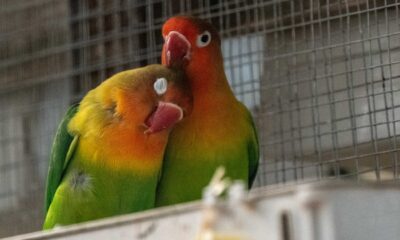Domestic Animals
Can Cats See Fire? ALL You Need To Know 2023

Last Updated on July 30, 2023 by israel olaniran
When it comes to cats, their mysterious behaviors and fascinating abilities have always intrigued us. One question that often pops up in the minds of curious cat owners is, “Can cats see fire?” In this article, we will explore the world of feline vision and dive into the intriguing aspects of how cats perceive the world around them, including their potential ability to see fire.
Read: why does my cat put his paw on my mouth?
can cats see fire?
While there is no definitive scientific evidence to confirm whether cats can see fire in the same way humans do, it is likely that they can perceive the movement and brightness of flames. Cats’ exceptional night vision, sensitivity to light, and keen ability to detect motion might make them aware of the flickering and dancing of flames.
Read: can a bug zapper kill a cat?
However, due to their limited color vision and unique visual adaptations, the vividness of fire’s colors might appear different to them compared to humans.
Nevertheless, cats are generally cautious around fire due to its association with heat and its unpredictable nature, which indicates that they recognize it as a potential danger.
How Cats See the World
Before delving into the specifics of feline vision, it’s essential to understand the anatomy of a cat’s eyes. Cats, like many other animals, have unique visual structures that enable them to excel in various lighting conditions.
Read: can cats eat pizza?
The Anatomy of a Cat’s Eyes
Cats possess vertically slit pupils that play a crucial role in regulating the amount of light entering their eyes. These pupils can dilate and contract rapidly, allowing cats to adjust to different levels of brightness efficiently. Additionally, cats have a reflective layer behind their retinas called the tapetum lucidum, which enhances their night vision capabilities.
🐾 Are you a dog owner who wants to ensure your dog gets the absolute best in terms of nutrition?
Read: are cats stronger than dogs?
Understanding Cat Vision
While cats have excellent night vision, their daytime vision differs significantly from that of humans. Cats have fewer cones in their eyes, which are responsible for detecting colors, particularly in bright light. As a result, their color vision is somewhat limited compared to humans.
Read: why do cats loaf?
Can Cats See Fire?
Sensitivity to Light and Colors
Due to their fewer cones, cats are not as sensitive to colors as humans are. They primarily perceive the world in shades of blue and green, making reds and oranges appear more muted. Fire emits a broad spectrum of colors, including shades of red and orange, which may not be as vivid for cats as they are for us.
Read: how long can a cat go without water?
Perception of Moving Objects
Cats, with their keen eyesight, can detect motion exceptionally well. When a fire burns, the flickering flames and dancing embers can catch a cat’s attention, particularly if they move in a way that simulates the movement of prey.
Read: why does my cat bite my nose?
The Role of Pupil Shape
The vertical slit pupils of cats provide them with an advantage in bright light conditions, but they may also influence how cats perceive certain shapes. While there is no definitive evidence that cats see flames as we do, the unique shape of their pupils might contribute to how they interpret dynamic patterns like fire.
Read: can a dog get a cat pregnant?
Night Vision in Cats
Adaptations for Low-Light Vision
Cats are crepuscular animals, which means they are most active during dawn and dusk when light levels are low. Their eyes have evolved to excel in these low-light conditions, allowing them to hunt effectively during the early and late hours.
Read: can cats be left in a dark house?
Hunting Behavior and Night Vision
Cats’ hunting instincts are deeply ingrained, and their exceptional night vision plays a vital role in their predatory success. While fire may not be a part of their natural environment, its movement and brightness could still trigger their curiosity.
Read: why does my cat bite me then lick me?
Cats’ Reaction to Fire
Experimental Studies
There have been limited studies exploring how cats react to fire, mainly because exposing animals to potential danger is ethically challenging. However, anecdotal evidence and observations suggest that most cats tend to be cautious around fire, likely due to its unpredictable nature and association with heat.
Read: can cats have ice cream?
Cautious Nature
Cats are instinctively wary of unfamiliar and potentially hazardous elements in their environment. When faced with fire, they are more likely to maintain a safe distance, displaying their innate self-preservation instincts.
Read: can cats have whipped cream?
Ensuring Safety for Cats and Fire
Fire Safety Measures for Cat Owners
As responsible pet owners, it is essential to take precautions to protect our feline friends from potential dangers like fire. Keeping candles, open flames, or hot surfaces out of reach can prevent accidents and keep your curious cat safe.
Read: do cats have belle button?
Creating a Cat-Friendly Environment
Understanding your cat’s behavior and preferences will help you create an environment where they feel secure and content. Providing alternative sources of entertainment and warmth, such as cat-friendly heating pads, can minimize their curiosity towards fire-related hazards.
Final Thoughts On can cats see fire
While we cannot be entirely certain about how cats perceive fire, it is evident that their vision and behavioral instincts influence their reactions to various stimuli. Cats’ unique visual adaptations make them exceptional hunters and offer us a glimpse into their captivating world.
Read: can cats eat french fries?
Can cats see colors?
Cats have limited color vision and primarily perceive the world in shades of blue and green.
Are cats attracted to fire?
Cats are generally cautious around fire due to its unpredictable nature and association with heat.
How do cats see in the dark?
Cats have excellent night vision, thanks to their reflective tapetum lucidum and vertically slit pupils.
Can cats see TV screens?
Cats may see moving images on TV screens, but they might not interpret them the same way humans do.
Do cats see better than dogs?
Cats generally have better visual acuity and night vision than dogs, which aids them in their hunting abilities.
Are cats aware of fire?
Cats are generally aware of fire, but their level of understanding might vary. They can perceive the movement and brightness of flames due to their keen vision, but they may not fully comprehend the concept of fire as humans do.
Why does my cat stare at fire?
Cats might stare at fire due to their curious nature. The flickering flames and dancing embers can catch their attention, similar to how they would react to moving prey or other intriguing stimuli.
How do cats react in a fire?
In the event of a fire, cats’ instincts typically lead them to be cautious and seek safety. They may try to distance themselves from the source of the fire due to their sensitivity to heat and their natural self-preservation instincts.
Can cats tell if something is hot?
Yes, cats can sense heat through their highly sensitive whiskers and paw pads. They will likely avoid touching or getting too close to something that feels hot to protect themselves from potential harm.
What does fire look like to cats?
The appearance of fire to cats might be influenced by their visual adaptations. While they can perceive the movement and brightness of flames, the colors might appear differently to them due to their limited color vision.
Domestic Animals
30 Fascinating Facts About Dogs You Probably Didn’t Know.

Last Updated on March 25, 2024 by israel olaniran
We all love dogs, yeah? But how well do we know this beautiful creatures, Here are 30 fascinating facts you probably didn’t know about dogs, Add anyone you know in the comment section.
30 Fascinating Facts About Dogs
- 1. Dogs are descendants of wolves and were domesticated by humans thousands of years ago.
- 2. There are hundreds of dog breeds, each with its own unique characteristics and traits.
- 3. The Basenji dog breed is known as the “barkless dog” because it produces a unique yodel-like sound instead of barking.
- 4. Dogs have an incredible sense of smell and can detect scents at concentrations as low as parts per trillion.
- 5. The Labrador Retriever is one of the most popular dog breeds in the world, known for its friendly and outgoing personality.
- 6. Dogs have three eyelids: an upper lid, a lower lid, and a third lid called the nictitating membrane, which helps keep their eyes moist and protected.
- 7. The Border Collie is considered one of the most intelligent dog breeds and excels in activities like agility, herding, and obedience.
- 8. Dogs have sweat glands only in their paw pads, so they primarily regulate their body temperature by panting.
- 9. The Chihuahua is the smallest dog breed in the world, with some individuals weighing less than 2 pounds.
- 10. Dogs have a highly developed sense of hearing and can detect sounds at frequencies much higher than humans.

- 11. The Australian Cattle Dog was bred to herd cattle and is known for its intelligence, agility, and endurance.
- 12. Dogs have an average lifespan of 10 to 15 years, although this varies depending on the breed and size of the dog.
- 13. The Greyhound is one of the fastest dog breeds, capable of reaching speeds up to 45 miles per hour.
- 14. Dogs have a “third eyelid” called the nictitating membrane, which helps keep their eyes moist and protected.
- 15. The Dalmatian breed is famous for its distinctive black or liver spotted coat.
- 16. Dogs are social animals that thrive on companionship and interaction with humans and other animals.
- 17. The Siberian Husky is known for its endurance and ability to withstand cold temperatures.
- 18. Dogs have an excellent sense of taste, with taste buds not only on their tongues but also on the roofs of their mouths and the back of their throats.
- 19. The Beagle is known for its keen sense of smell and is often used in scent detection work.
- 20. Dogs have a unique set of vocalizations, including barking, howling, whining, and growling, to communicate with humans and other dogs.
Read: 30 interesting facts about lovebirds.
- 21. The Golden Retriever is a popular breed known for its friendly and gentle temperament, making it an excellent family pet.
- 22. Dogs have an innate sense of hierarchy and social structure within their packs, which can influence their behavior and interactions with other dogs and humans.
- 23. The Poodle is known for its intelligence and hypoallergenic coat, making it a popular choice for people with allergies.
- 24. Dogs have an incredible sense of direction and can navigate using landmarks, scents, and celestial cues.
- 25. The Bulldog breed is characterized by its loose, wrinkled skin, distinctive pushed-in nose, and muscular build.
- 26. Dogs are capable of forming strong bonds with their human companions and are known for their loyalty and devotion.
- 27. The German Shepherd is a versatile and intelligent breed often used in roles such as police work, search and rescue, and therapy.
- 28. Dogs have whiskers, or vibrissae, located on their muzzle, eyebrows, and chin, which help them sense vibrations and navigate in dim light.
- 29. The Shih Tzu is a small breed known for its long, flowing coat and friendly disposition.
- 30. Dogs communicate using a combination of body language, vocalizations, and facial expressions to convey their emotions, needs, and intentions.
How many of them did you know? Tell us
-
Domestic Animals2 years ago
Why Do Dogs Look Away When You Eat
-
Domestic Animals6 months ago
Small But Smart: 10 Most Intelligent Small Dog Breeds
-
Wild Animals2 years ago
What Does Snake Poop Look Like? PICTURES & VIDEOS
-
Pet News6 months ago
Trending Now: Woman Raised A Panther Thinking It Was A Cat.
-
Domestic Animals8 months ago
Why Does My Cat Sleep On My Feet? Best Reasons
-
Insects7 months ago
Australian Stick Bug: ALL You Need To Know.
-
Domestic Animals1 year ago
Can Guinea Pigs Eat Oranges? ALL You Need To Know!
-
Domestic Animals2 years ago
Can Guinea Pigs Eat Pears? All You Need To Know (2023)






















